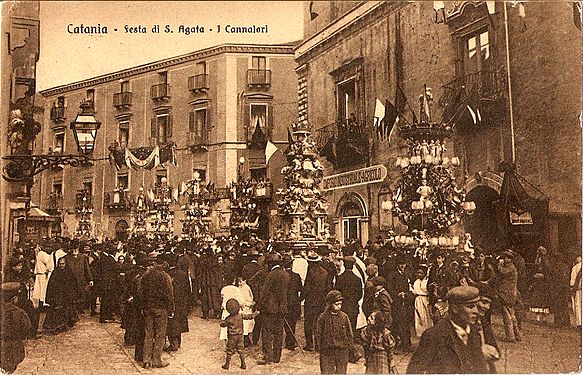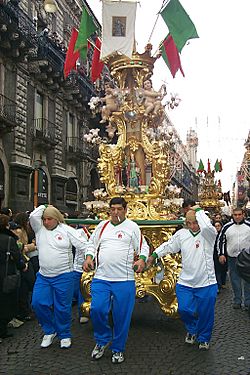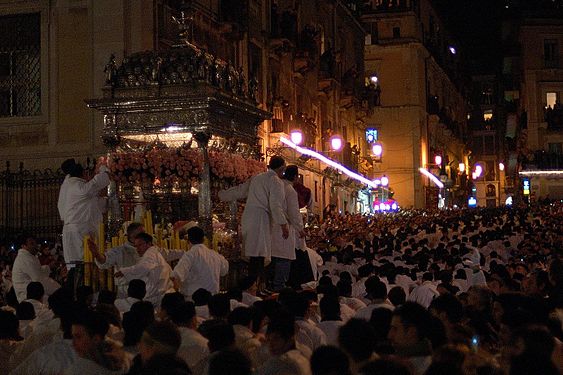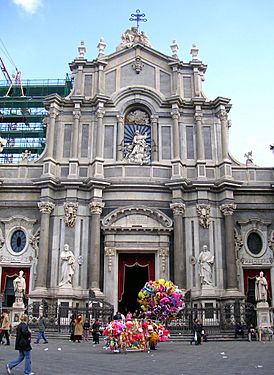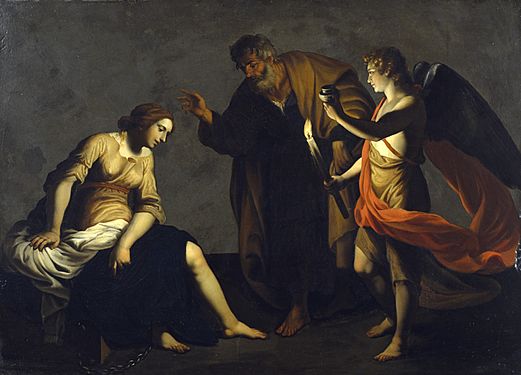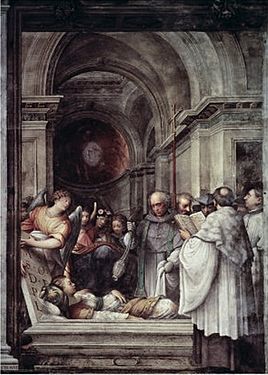Agatha of Sicily facts for kids
Quick facts for kids SaintAgatha of Sicily |
|
|---|---|
| Virgin and Martyr | |
| Born | c. 231 Catania, Sicily |
| Died | c. 251 Catania, Sicily |
| Venerated in | |
| Canonized | Pre-congregation by tradition confirmed by Pope Gregory I |
| Feast | 5 February |
| Patronage |
|
Saint Agatha of Sicily (born around 231 AD, died around 251 AD) is a very important Christian saint. Her special day, called a feast day, is celebrated every year on February 5th. Agatha was born in a city called Catania on the island of Sicily, which was part of the Roman Empire back then. She died for her faith around the year 251 AD.
Agatha is known as the patron saint of many places, including Catania, Molise, Malta, and San Marino. She is also a special helper for people with breast cancer, martyrs (people who die for their beliefs), wet nurses, and people who make bells or bake bread. People also ask for her help to protect them from fires, earthquakes, and eruptions of Mount Etna, a famous volcano.
Contents
Who Was Saint Agatha?
Agatha is buried in a church called Badia di Sant'Agata in Catania. Her name appears in old church calendars from the 500s AD, showing that she was recognized as a saint very early on.
Two churches in Rome were built to honor her a long time ago. One of them, called "Saint Agatha of the Goths," was later used by a different Christian group before being given back to the main church by Pope Gregory the Great. Her image can also be seen in beautiful old mosaics in a church in Ravenna, Italy, where she is shown in a procession of female saints.
Agatha's Story
Agatha was one of the most respected young women who died for her Christian faith a long time ago. She was put to death in Catania, Sicily, during a time when Christians were being persecuted (treated badly) by the Roman Emperor Decius, around 250-253 AD.
According to an old book called Golden Legend, Agatha was a 15-year-old from a rich family. She had promised to stay pure and dedicated to God. A Roman official named Quintianus was very interested in her and wanted her to marry him. But Agatha refused his offers again and again.
Since this was during a time when Christians were being hunted down, Quintianus, knowing Agatha was a Christian, reported her to the authorities. He was actually the governor of the area. Quintianus thought that if he threatened her with pain and even death, Agatha would change her mind and marry him. But Agatha simply prayed and stood firm in her faith.
Quintianus tried to argue with her and threaten her again. When she still refused, he had her put in prison and badly hurt. After more difficult talks with Quintianus, where Agatha showed great courage and strong faith, she was sentenced to be burned. However, an earthquake happened, which stopped this from taking place. She was then sent back to prison.
In prison, it is said that Saint Peter the Apostle appeared to her and healed her wounds. Agatha died in prison, probably in the year 251 AD. Even though we know for sure that Agatha was a real person who died for her faith and was honored as a saint very early on, the exact details of her death are not fully known.
Honoring Saint Agatha
In Malta, there's a story that during the Roman persecution, Agatha and her friends escaped from Sicily and found safety in Malta. Some historians believe she stayed there for a short time, spending her days in a cave, praying and teaching Christianity to children. After some time, Agatha returned to Sicily, where she faced her death.
The cave where Saint Agatha supposedly stayed in Malta is now an underground church called the Crypt of St. Agatha. It was a small natural cave that was made bigger and more beautiful in the 4th or 5th century.
Many churches, especially in the Catholic Church, celebrate Saint Agatha. Her feast day is on February 5th.
Festival of Saint Agatha in Catania
The Festival of Saint Agatha in Catania, Sicily, is a very big and important celebration in the region. It takes place for the first five days of February. The main church in Catania, called the Catania Cathedral, is dedicated to her.
What is Saint Agatha the Patron Of?
Saint Agatha is the patron saint of people with breast cancer, wet nurses, and bell-makers. She is also believed to be a powerful helper when people are in danger from fires. Her feast day is celebrated on February 5th.
She is also a patron saint of Malta. In 1551, it is believed that her help, through a vision to a nun, saved Malta from an invasion by the Turkish army.
Agatha also became the patron saint of the Republic of San Marino. This happened because Pope Clement XII gave the state its independence back on her feast day, February 5th, in 1740.
She is also a patron saint of Catania, Molise, and a part of Palermo called Kalsa. The year after she died, people believed that an eruption of Mount Etna stopped because of her prayers. Because of this, people continued to ask for her help to protect them from fire.
In Switzerland, Agatha is seen as the patron saint of fire services. In the United Kingdom, she is the patron saint of bell ringers in the Catholic Church.
Agatha's Lasting Impact
The Basque people have a special tradition on Saint Agatha's Eve. They gather and walk around their village, singing a song about her life. They tap their walking sticks on the ground to the beat. Homeowners can choose to listen to the song or a prayer for their family. After the song, the homeowner gives food to the singers. The words of this song change depending on the local tradition and the Basque language.
The annual festival in Catania, Sicily, from February 3rd to 5th, celebrates Saint Agatha's life. The festival ends with a procession through the city that lasts all night.
St. Agatha's Tower is an old fortress in Malta. This tower, built in the 1600s, was used as a military base during both World Wars and later as a radar station by the Maltese army.
Saint Agatha is also remembered in books and poems. An Italian poet named Martha Marchina wrote a poem about Agatha's death, saying that Agatha became even more beautiful and powerful through her suffering.
Saint Agatha of Sicily is honored with a special day on the church calendar of the Episcopal Church in the United States of America on 5 February.
In Art
Agatha is featured in The Dinner Party, a famous art piece by Judy Chicago from 1979. She is one of the 999 women whose names are written on the floor of the artwork.
-
Saint Agatha Attended by Saint Peter and an Angel in Prison by Alessandro Turchi
See Also
 In Spanish: Águeda de Catania para niños
In Spanish: Águeda de Catania para niños
- Incorruptibility
- List of Catholic saints
- Saint Agatha of Sicily, patron saint archive
- Santa Gadea, a church of historical importance devoted to Agatha, located in Burgos



